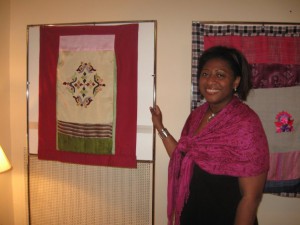
Jacqueline Bishop, 2008-2009, Morocco, at an exhibition of her patchwork quilts made from Moroccan djellabas and scarves in Morocco
Sometimes you go in search of one thing, and yes, you find that one thing, but you find many other things as well. That is what my Fulbright year in Morocco was like.
I went to Morocco to study the burgeoning lifestyle magazine industry that had sprung up in the country over recent years. Within a very short period of time there were several “du Maroc” (of Morocco) magazines being published in the country – Cuisine du Maroc, Architecture du Maroc, Jardins du Maroc – and I was intrigued by the phenomenon. I wondered: Why are all these magazines now being published in Morocco? In time I came to realize that this all had to do with a burgeoning middle class.
But Morocco held many surprises for me. I discovered, for example, a rich embroidery tradition rooted in the history of Morocco. In time, because I am a visual artist, I started to utilize this embroidery in the creation of a series of patchwork quilts. In these quilts, there is a central embroidery around which I used various textiles often associated with women – scarves and djellabas in particular – both to emphasize the main embroidery and to extend the quilts into patchworks. In effect I was marrying both African American and Moroccan art forms.
Both the United States Embassy in Morocco and the Moroccan-American Commission for Educational & Cultural Exchange were subsequently so enamored with the quilts I made that they both ended up exhibiting them in Morocco. Since then, these quilts have gone on to be exhibited in Italy, Jamaica and the United States. This was a wholly unexpected outcome and something that I could not have predicted in going to Morocco on a Fulbright Fellowship.
The other great discovery I had in Morocco was that the African American writer Claude McKay (September 15, 1889 – May 22, 1948) lived in the country in 1928-1929; and again in 1930-1934. During that time, McKay did an astonishing body of work. He completed his second novel Banjo on his first trip in 1928. He also completed the short story collection Gingertown and the novels Banana Bottom and Savage Loving (which would later be re-titled, Romance in Marseilles) in Morocco. Sometime in 1933, McKay thought of a new novel and began to write what would eventually become Harlem Glory. In addition, he wrote several poems, essays and various sketches of Moroccan life while still living in the country. Later, McKay dedicates a significant portion of his autobiography to his time in Morocco and the country keeps showing up in subsequent works as well.
But I was finding out that almost no one in Morocco knew that the celebrated writer had lived and worked in the country. Even more surprising were the people who knew of Claude McKay’s importance as a writer, without knowing that he had written most of his books in Morocco. Back in the United States, almost no one seemed to take seriously the author’s time in Morocco, and treated his time there as an extended vacation, when, in fact, it was so much more than that. To fill this lacuna, the Moroccan photographer Lhouceine Aamar (who, coincidentally, just received a Humphrey H. Fellowship to the United States) and I decided to execute a series of large-scale photographs of the places that Claude McKay lived in and wrote about Morocco, which remains an ongoing project. This too, is another wonderful surprise of my Fulbright year in Morocco.
Morocco continues to infuse and inform my own life and my own work. I am so thankful for the time I spent as a Fulbrighter there. The advice that I would give to those going off on a Fulbright grant is to be open to the unexpected. Yes, you came in search of one thing, but you might find a whole other thing. In fact, a whole other universe might unfold in front of your very astonished eyes.
To learn more about Jacqueline and her work, click here to read her interview in The Huffington Post. Jacqueline also recently received a grant from Museums Connect, another program sponsored by the U.S. Department of State’s Bureau of Educational and Cultural Affairs, for her collaborative work with The Fabric Workshop and Museum in Philadelphia, and with the Tangier American Legation Institute for Moroccan Studies. Read more about Jacqueline’s latest award here.

No Comments